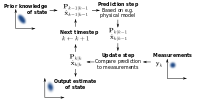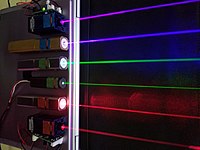
Effects of stimulating the supplementary motor area with a transcranial alternating current for bimanual movement performance
Sign Up to like & getrecommendations! Published in 2020 at "Behavioural Brain Research"
DOI: 10.1016/j.bbr.2020.112801
Abstract: Transcranial alternating current stimulation (tACS) can regulate the frequency of neuronal activity in the cerebral cortex. Beta (β) activity in the supplementary motor area (SMA) is involved in motor planning and maintenance while gamma (γ)… read more here.
Keywords: condition; alternating current; motor; performance ... See more keywords

Chronic Insomnia: Treatment with Transcranial Alternating Current Stimulation
Sign Up to like & getrecommendations! Published in 2021 at "Brain Stimulation"
DOI: 10.1016/j.brs.2021.05.007
Abstract: Chronic insomnia is one of the most common types of sleep disorder [1]. The incidence of chronic insomnia in the general population ranges from 4% to 48% [2]. Because of its high prevalence and increased… read more here.
Keywords: insomnia; stimulation; treatment; chronic insomnia ... See more keywords

P166 Evidence for state dependent direct effects of alpha band transcranial alternating current stimulation
Sign Up to like & getrecommendations! Published in 2017 at "Clinical Neurophysiology"
DOI: 10.1016/j.clinph.2016.10.287
Abstract: Introduction Transcranial alternating current stimulation (tACS) is used to modulate brain oscillations to measure changes in cognitive function. It is only since recently that brain activity in human subjects during tACS can be investigated. Objectives… read more here.
Keywords: state; current stimulation; alternating current; tacs ... See more keywords

P175 The effect of transcranial alternating current stimulation on probabilistic learning
Sign Up to like & getrecommendations! Published in 2017 at "Clinical Neurophysiology"
DOI: 10.1016/j.clinph.2016.10.296
Abstract: Probabilistic learning is a fundamental mechanism of the brain, which extracts and represents regularities of our environment enabling predictive processing during perception and acquisition of perceptual, motor, cognitive, and social skills. Previous studies showed that… read more here.
Keywords: learning; current stimulation; probabilistic learning; alternating current ... See more keywords

Transcranial alternating current stimulation modulates cortical processing of somatosensory information in a frequency- and time-specific manner
Sign Up to like & getrecommendations! Published in 2022 at "NeuroImage"
DOI: 10.1016/j.neuroimage.2022.119119
Abstract: Neural oscillations can be modulated by non-invasive brain stimulation techniques, including transcranial alternating current stimulation (tACS). However, direct evidence of tACS effects at the cortical level in humans is still limited. In a tACS-electroencephalography co-registration… read more here.
Keywords: tacs; frequency; somatosensory information; transcranial alternating ... See more keywords

Optimizing the montage for cerebellar transcranial alternating current stimulation (tACS): a combined computational and experimental study
Sign Up to like & getrecommendations! Published in 2022 at "Journal of Neural Engineering"
DOI: 10.1088/1741-2552/ac676f
Abstract: Objective. The application of cerebellar transcranial alternating current stimulation (tACS) is limited by the absence of commonly agreed montages and also the presence of unpleasant side effects. We aimed to find the most effective cerebellar… read more here.
Keywords: cerebellar transcranial; tacs; alternating current; stimulation ... See more keywords

Medial prefrontal transcranial alternating current stimulation for apathy in Huntington's disease
Sign Up to like & getrecommendations! Published in 2022 at "Progress in Neuro-Psychopharmacology and Biological Psychiatry"
DOI: 10.1101/2022.08.29.22279310
Abstract: We investigated the effects of transcranial alternating current stimulation (tACS) targeted to the bilateral medial prefrontal cortex (mPFC) and administered at either delta or alpha frequencies, on brain activity and apathy in people with Huntingtons… read more here.
Keywords: tacs; alternating current; medial prefrontal; transcranial alternating ... See more keywords

Removal of Transcranial Alternating Current Stimulation EEG Artifacts Using Blind Source Separation and Wavelets
Sign Up to like & getrecommendations! Published in 2022 at "IEEE Transactions on Biomedical Engineering"
DOI: 10.1109/tbme.2022.3162490
Abstract: Abstract Goal: Transcranial alternating current stimulation (tACS) is a non-invasive technology for modulating brain activity, with significant potential for improving motor and cognitive functions. To investigate the effects of tACS, many studies have used electroencephalographic… read more here.
Keywords: tacs; alternating current; brain; stimulation ... See more keywords

Utilizing Transcranial Alternating Current Stimulation and Functional Neuroimaging to Investigate Human Sensory Adaptation.
Sign Up to like & getrecommendations! Published in 2020 at "Journal of neurophysiology"
DOI: 10.1152/jn.00215.2020
Abstract: Sensory adaptation is the reduction of neural activity after repeated exposure to a stimulus. In a recent study, Kar et al. (2019) found that implementation of 10Hz-tACS to the human middle temporal cortex (hMT+) decreased… read more here.
Keywords: current stimulation; alternating current; adaptation; utilizing transcranial ... See more keywords

Bilateral Gamma/Delta Transcranial Alternating Current Stimulation Affects Interhemispheric Speech Sound Integration
Sign Up to like & getrecommendations! Published in 2019 at "Journal of Cognitive Neuroscience"
DOI: 10.1162/jocn_a_01498
Abstract: Perceiving speech requires the integration of different speech cues, that is, formants. When the speech signal is split so that different cues are presented to the right and left ear (dichotic listening), comprehension requires the… read more here.
Keywords: phase; integration; stimulation; speech ... See more keywords

Directionality of the injected current targeting the P20/N20 source determines the efficacy of 140 Hz transcranial alternating current stimulation (tACS)-induced aftereffects in the somatosensory cortex
Sign Up to like & getrecommendations! Published in 2022 at "PLoS ONE"
DOI: 10.1371/journal.pone.0266107
Abstract: Interindividual anatomical differences in the human cortex can lead to suboptimal current directions and may result in response variability of transcranial electrical stimulation methods. These differences in brain anatomy require individualized electrode stimulation montages to… read more here.
Keywords: injected current; 140 transcranial; tacs; source ... See more keywords